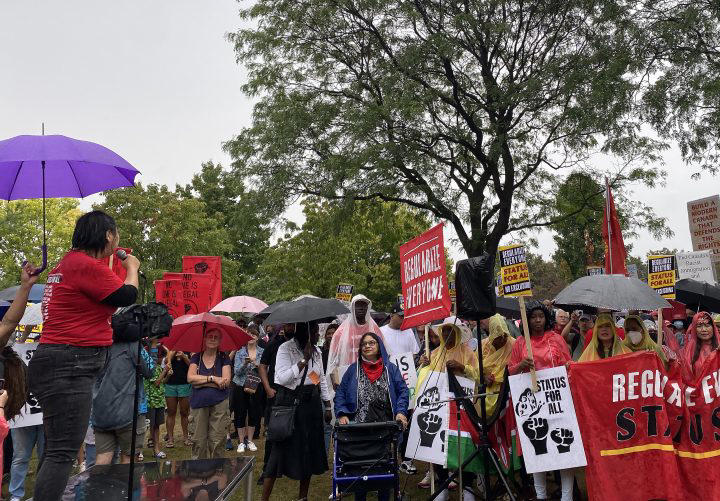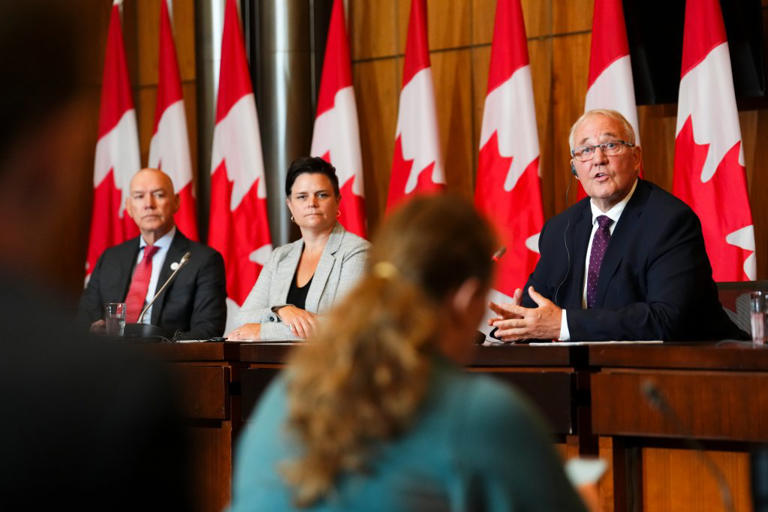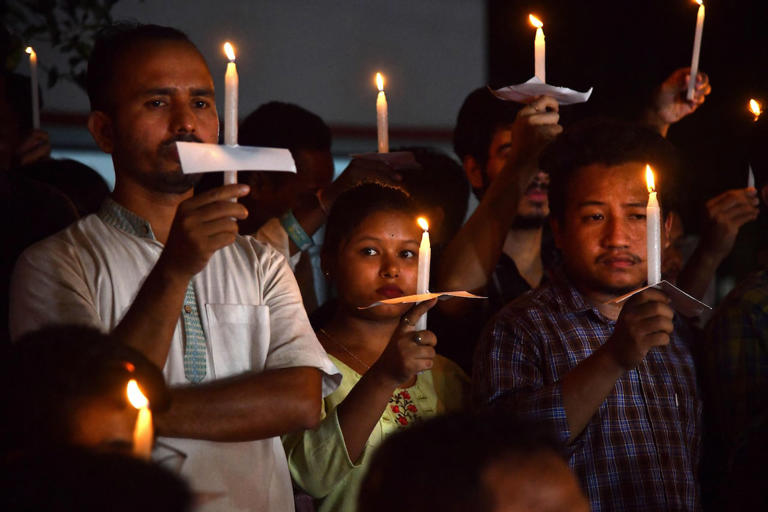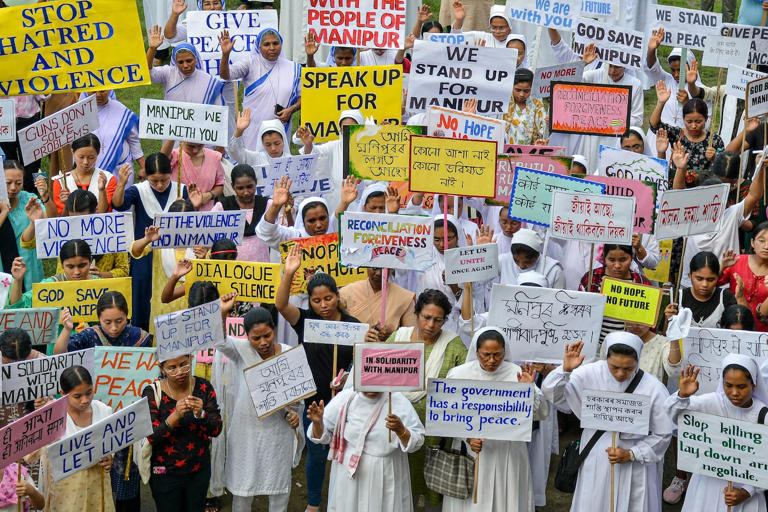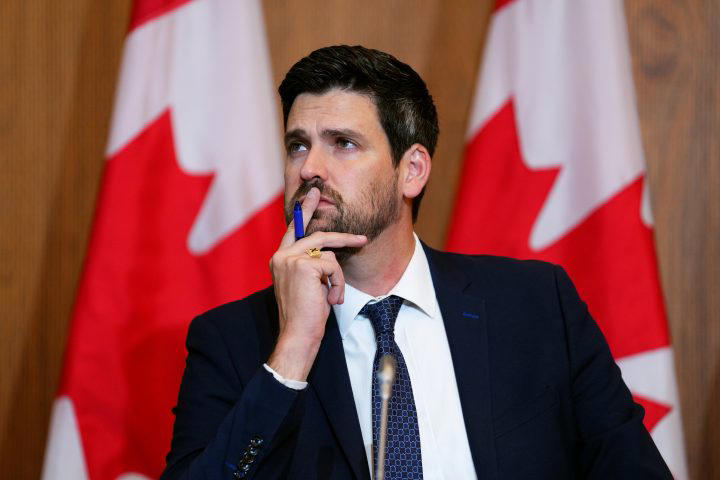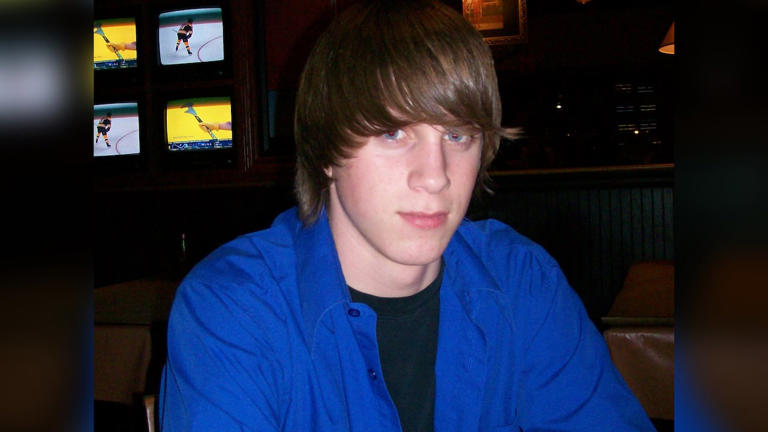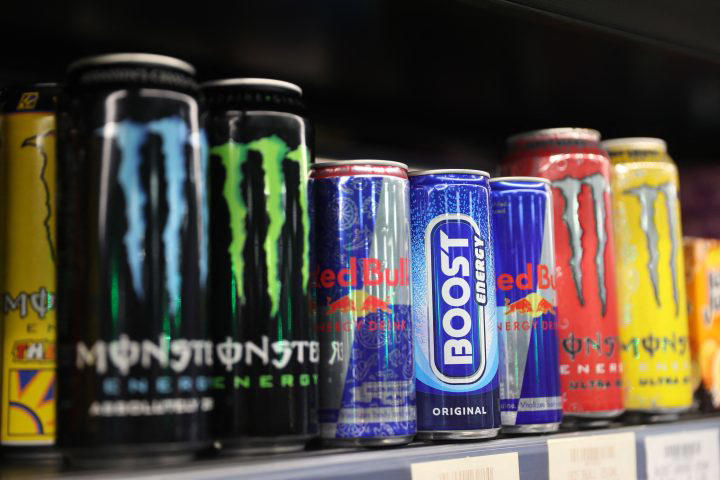Story by Naomi Barghiel • Jul 7, 2023
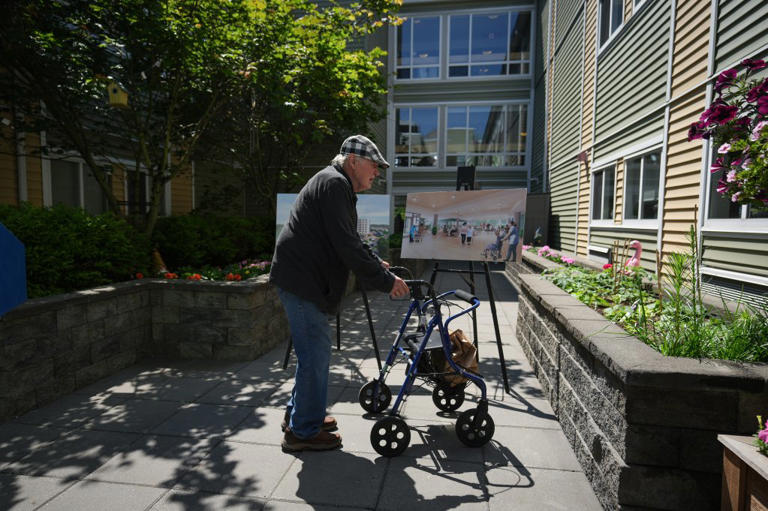
A resident of a long-term care home stops to look at renderings of the new Richmond Lions Manor-Fentiman care home before a provincial government news conference announcing the project, in Richmond, B.C., on Thursday, June 22, 2023. The eight-storey building will have 144 long-term care beds and 14 hospice beds and be built on the site of a former care home in Richmond's Steveston neighbourhood. Construction will begin in 2025 and is expected to be complete in 2028.
THE CANADIAN PRESS/Darryl Dyck©
How renters face challenges during extreme heatwaves
As the country breaks heat wave records this week, some advocates are raising concerns about a lack of funding and clear and consistent mandates across Canada to keep vulnerable residents in long-term care homes cool.
It is currently the responsibility of each province and territory’s government to develop and enforce standards for individual long-term care facilities, which includes air circulation and temperature control. Many provinces’ policies are informed by national standards recently updated this year, but they are not mandatory.
Some advocates say the inconsistency is part of what has led to some long-term care homes operating without proper cooling measures needed during hot weather.
“We obviously need to make it a standard rule that we have central heating and cool air in all of these facilities,” said Vivian Stamatopoulos, a long-term care advocate and professor at Ontario Tech University.
“We know there's a well-known correlation between high ambient temperature and negative health, particularly among seniors. The fact that we don't have basic standards at every facility, knowing that climate change is real and knowing that we are only going to see more extreme health-related events in the next few years ... this is clearly an area where elected officials dropped the ball.”
The federal government announced in February that they will be investing $198.6 billion over 10 years to improve health services for Canadians with a focus on key health priorities, including helping Canadians age safely and with dignity.
"As a government, we will continue to our work with provinces and territories to help all Canadians, including seniors, get the care they deserve when and wherever they need it," Minister of Health Jean-Yves Duclos said in a press release.
"We will also always ensure that those who live or work in LTC homes do so in a positive, safe, and quality environment.”
The federal government’s 2021 budget included $3 billion in funding over five years to support provinces and territories in their efforts to improve long-term care in their jurisdictions. The government also provided close to $850,000 in funding to the Health Standards Organization (HSO) and the CSA Group to develop the most recent national standards released in January this year.
Experts with HSO said in January that the new standards will only be useful if the government puts them into practice and makes sure they are followed.
However, the National Institute on Ageing revealed in a report released Wednesday that some provinces are falling far short of the national standards.
The institute’s report found that only 25 of the 117 criteria laid out in the national standards could be found in the policies of all provinces and territories, as of December 2022.
“It reminds us that there’s a lot to be done,” said Dr. Samir Sinha, the report’s co-author and director of health policy research at the institute.
According to an email from CSA Group to Global News Thursday, the standards include long-term care home building systems, such as HVAC and medical gas systems, along with catastrophic event management involving extreme temperature conditions.
The organization along with HSO issued the updated guidance for operating care homes in light of the deadly and tragic toll the COVID-19 pandemic took on Canadian residents and their quality of life.
CSA confirmed that the standards are intended only as a guide to be referenced in legislation.
“Although our hope is that the standard is mandated, even as a voluntary standard, it is intended to serve as important guidance for long-term care stakeholders that are building new long-term care homes or enhancing the safety and quality of life in existing homes,” said a spokesperson for CSA.
Environment Canada issued several heat warnings this week, with temperatures surpassing 30 C in most jurisdictions. Warnings remain in place Friday morning for eastern Ontario, Quebec, British Columbia and some parts of the East Coast.
Ontario is one of the provinces making big steps toward progress. Last summer, Global News reported that 90 long-term care homes in Ontario still did not have air conditioning installed in resident rooms. The government then promised to crack down on homes that weren't complying with the province's legislation passed in June 2021, requiring air conditioning to be installed in all resident rooms.
The province saw improvement this year partly by passing legislation that allows the government to slap heavy fines on non-complying homes, and by conducting an "inspections blitz," the Ontario ministry told Global News in an email Thursday.
Now, 99.5 per cent of all LTC homes in Ontario are equipped with air conditioning in residents’ rooms.
Currently, air conditioning in British Columbia long-term care homes is not compulsory. While most of the province’s long-term care facilities are equipped with HVAC systems, they are not required in residents’ rooms.
B.C. seniors’ advocate Isobel Mackenzie says she wants the province to follow Ontario’s lead.
“I think that there is merit to saying you need to have a cooling system sufficient to ensure that the temperatures in residents' rooms never fall below ‘this’ and never rise above ‘this’ and then regulate and inspect against that standard. That isn't our current approach,” Mackenzie said.
“I do think we should look at these absolute temperature standards, both in terms of maximum heat and in terms of maximum coldness in a particular resident's room and then work our way towards compliance from that point.”
Though it is stated in the province’s Community Care and Assisted Living Act that each facility must ensure temperatures in each bedroom, bathroom and common room are “safe and comfortable,” the Ministry of Health says aging buildings pose a challenge to making air conditioning a requirement.
“In some cases, forced air directly in resident rooms is possible, in other cases, central air through common rooms and hallways is the most achievable upgrade. In these cases, fans are placed at resident doorways to ensure that resident rooms remain at cool temperatures,” a spokesperson from the Ministry of Health explained.
The federal government announced in March that "in the coming months" it would "move forward with consultations and engagement with stakeholders and Canadians on the Safe Long-Term Care Act," which was first pledged by the Liberal party during the 2021 election.
According to a press release, any legislation will be based on the new standards set by the HSO and CSA Group.
It remains to be seen how the federal legislation will be framed.
Canadian Association of Long-Term Care (CALTC) CEO Jodi Hall says the federal government could do more to help LTC homes meet standards through proper funding.
“As we move forward in long-term care to continuously enhance person centered care … it is essential that there is on-going investment by all levels of government to modernize existing homes, replace when needed, and develop new homes that addresses the current demand for long term care,” Hall told Global News in an emailed statement.
“A Federal infrastructure fund that specifically allows long-term care homes to access funding for infrastructure investment and adapt energy efficient systems would go a long way to make necessary improvements in homes across the country.”
Mackenzie says one opportunity for change lies within the National Building Code. According to the government of Canada’s webpage, the code “sets out technical requirements for the design and construction of new buildings, as well as the alteration, change of use and demolition of existing buildings.”
Mackenzie says there is “definitely” a role the government could play in deciding how they use the code to positively impact long-term care infrastructure in the short term and long term. Short term, the government can use the code to support care homes and make the necessary accommodations to ensure residents truly are cool and comfortable.
Mackenzie says that in the future, the government could make air conditioning and proper cooling part of the building code in new buildings.
“I think that’s a reasonable approach,” she said.
-- with files from The Canadian Press.
How renters face challenges during extreme heatwaves
As the country breaks heat wave records this week, some advocates are raising concerns about a lack of funding and clear and consistent mandates across Canada to keep vulnerable residents in long-term care homes cool.
It is currently the responsibility of each province and territory’s government to develop and enforce standards for individual long-term care facilities, which includes air circulation and temperature control. Many provinces’ policies are informed by national standards recently updated this year, but they are not mandatory.
Some advocates say the inconsistency is part of what has led to some long-term care homes operating without proper cooling measures needed during hot weather.
“We obviously need to make it a standard rule that we have central heating and cool air in all of these facilities,” said Vivian Stamatopoulos, a long-term care advocate and professor at Ontario Tech University.
“We know there's a well-known correlation between high ambient temperature and negative health, particularly among seniors. The fact that we don't have basic standards at every facility, knowing that climate change is real and knowing that we are only going to see more extreme health-related events in the next few years ... this is clearly an area where elected officials dropped the ball.”
The federal government announced in February that they will be investing $198.6 billion over 10 years to improve health services for Canadians with a focus on key health priorities, including helping Canadians age safely and with dignity.
"As a government, we will continue to our work with provinces and territories to help all Canadians, including seniors, get the care they deserve when and wherever they need it," Minister of Health Jean-Yves Duclos said in a press release.
"We will also always ensure that those who live or work in LTC homes do so in a positive, safe, and quality environment.”
The federal government’s 2021 budget included $3 billion in funding over five years to support provinces and territories in their efforts to improve long-term care in their jurisdictions. The government also provided close to $850,000 in funding to the Health Standards Organization (HSO) and the CSA Group to develop the most recent national standards released in January this year.
Experts with HSO said in January that the new standards will only be useful if the government puts them into practice and makes sure they are followed.
However, the National Institute on Ageing revealed in a report released Wednesday that some provinces are falling far short of the national standards.
The institute’s report found that only 25 of the 117 criteria laid out in the national standards could be found in the policies of all provinces and territories, as of December 2022.
“It reminds us that there’s a lot to be done,” said Dr. Samir Sinha, the report’s co-author and director of health policy research at the institute.
According to an email from CSA Group to Global News Thursday, the standards include long-term care home building systems, such as HVAC and medical gas systems, along with catastrophic event management involving extreme temperature conditions.
The organization along with HSO issued the updated guidance for operating care homes in light of the deadly and tragic toll the COVID-19 pandemic took on Canadian residents and their quality of life.
CSA confirmed that the standards are intended only as a guide to be referenced in legislation.
“Although our hope is that the standard is mandated, even as a voluntary standard, it is intended to serve as important guidance for long-term care stakeholders that are building new long-term care homes or enhancing the safety and quality of life in existing homes,” said a spokesperson for CSA.
Environment Canada issued several heat warnings this week, with temperatures surpassing 30 C in most jurisdictions. Warnings remain in place Friday morning for eastern Ontario, Quebec, British Columbia and some parts of the East Coast.
Ontario is one of the provinces making big steps toward progress. Last summer, Global News reported that 90 long-term care homes in Ontario still did not have air conditioning installed in resident rooms. The government then promised to crack down on homes that weren't complying with the province's legislation passed in June 2021, requiring air conditioning to be installed in all resident rooms.
The province saw improvement this year partly by passing legislation that allows the government to slap heavy fines on non-complying homes, and by conducting an "inspections blitz," the Ontario ministry told Global News in an email Thursday.
Now, 99.5 per cent of all LTC homes in Ontario are equipped with air conditioning in residents’ rooms.
Currently, air conditioning in British Columbia long-term care homes is not compulsory. While most of the province’s long-term care facilities are equipped with HVAC systems, they are not required in residents’ rooms.
B.C. seniors’ advocate Isobel Mackenzie says she wants the province to follow Ontario’s lead.
“I think that there is merit to saying you need to have a cooling system sufficient to ensure that the temperatures in residents' rooms never fall below ‘this’ and never rise above ‘this’ and then regulate and inspect against that standard. That isn't our current approach,” Mackenzie said.
“I do think we should look at these absolute temperature standards, both in terms of maximum heat and in terms of maximum coldness in a particular resident's room and then work our way towards compliance from that point.”
Though it is stated in the province’s Community Care and Assisted Living Act that each facility must ensure temperatures in each bedroom, bathroom and common room are “safe and comfortable,” the Ministry of Health says aging buildings pose a challenge to making air conditioning a requirement.
“In some cases, forced air directly in resident rooms is possible, in other cases, central air through common rooms and hallways is the most achievable upgrade. In these cases, fans are placed at resident doorways to ensure that resident rooms remain at cool temperatures,” a spokesperson from the Ministry of Health explained.
The federal government announced in March that "in the coming months" it would "move forward with consultations and engagement with stakeholders and Canadians on the Safe Long-Term Care Act," which was first pledged by the Liberal party during the 2021 election.
According to a press release, any legislation will be based on the new standards set by the HSO and CSA Group.
It remains to be seen how the federal legislation will be framed.
Canadian Association of Long-Term Care (CALTC) CEO Jodi Hall says the federal government could do more to help LTC homes meet standards through proper funding.
“As we move forward in long-term care to continuously enhance person centered care … it is essential that there is on-going investment by all levels of government to modernize existing homes, replace when needed, and develop new homes that addresses the current demand for long term care,” Hall told Global News in an emailed statement.
“A Federal infrastructure fund that specifically allows long-term care homes to access funding for infrastructure investment and adapt energy efficient systems would go a long way to make necessary improvements in homes across the country.”
Mackenzie says one opportunity for change lies within the National Building Code. According to the government of Canada’s webpage, the code “sets out technical requirements for the design and construction of new buildings, as well as the alteration, change of use and demolition of existing buildings.”
Mackenzie says there is “definitely” a role the government could play in deciding how they use the code to positively impact long-term care infrastructure in the short term and long term. Short term, the government can use the code to support care homes and make the necessary accommodations to ensure residents truly are cool and comfortable.
Mackenzie says that in the future, the government could make air conditioning and proper cooling part of the building code in new buildings.
“I think that’s a reasonable approach,” she said.
-- with files from The Canadian Press.

